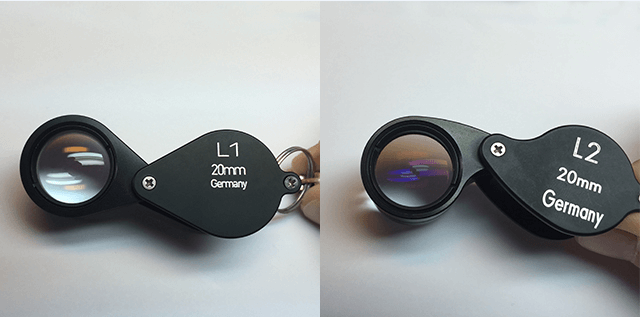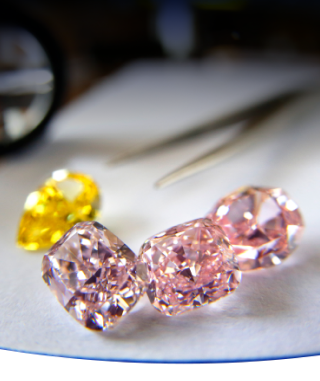Professional fancy color diamond dealers rely on their visual perception above all else. Aside from substandard lighting conditions, they never doubt the accuracy of their loupe when evaluating a diamond’s color.
The Harald Schneider 10x loupe is available in two models: the L1 and the L2. When looking through the lens of an L2, a diamond exhibits a purple tint, which distorts the actual color of the stone. The perceptibility of purple depends on which side of the loupe is used to view the diamond, as one side of the lens displays a significantly stronger purple in the stone. The L1 does not show any purple reflection and presents the true color of a diamond.
We asked three fancy color diamond dealers[1] to test the L1 and L2 loupes and all stated that they detected a noticeable difference in the undertone of a fancy color diamond when comparing the two loupe models. When they analyzed a grey diamond through an L2 loupe, it was assumed that the color of the stone was grey violet. Subsequently, they tested the same stone with an L1 loupe, and the stone was grey (a grey diamond with an undertone of purple is commercially preferred to a grey blue). The same effect occurred when analyzing the color of an Intense Purplish Pink, though the contrast in color was not as strong.
The L1 and L2 are sold with an identical explanation of the product in regard to viewing color and this issue is not brought to light when buyers are purchasing a loupe. In fact, the L2 is the preferred model by retailers and the L1 is not offered as an option unless it is specifically requested.
How to identify a problematic loupe:
Place the loupe under a daylight fluorescent lamp and tilt it under the light to see if a reflection of purple appears on the lens, as opposed to a white reflection. If a purple tone is detected, it is not a loupe that can be used to accurately grade fancy color diamonds. The L2 reflects purple on the lens because it is manufactured with very thin glass, which is popular in the industry due to its lighter weight. The lens on the L1 is 18mm thick and the L2 is 14mm thick.
As stated by a representative at Harald Schneider, professionals cannot rely on an L2 loupe to accurately evaluate color, but they assert that the L2 has greater optical transparency (though the industry professionals who tested both loupes did not notice a greater transparency) and are aware that the L2 reflects purple in the lens.
The variance in color between the L1 and L2 is so significant that some fancy color diamonds – such as blues, grey blues, highly saturated pinks and even Vivid yellows – are a completely different hue when perceived by the naked eye, a factor that can definitely affect the price one is willing to pay for a stone.
[1] Benny Elimelech, Eden Rachminov, Naphtali Stern


